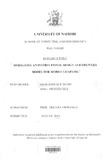| dc.description.abstract | Mobile learning empowers learners to acquire knowledge anywhere and anytime. Using mobile technologies in a well-designed instructional and delivery system can highly complement if not replace traditional teaching methodologies. This study was designed to model a framework of an instructional design and delivery model. The framework is envisaged to aid system developers for mobile technologies and instructors who wish to use mobile technologies to instruct learners. This study draws its strength from mobile learning theory which borrows a lot from Behaviorist, Cognitivist, Constructivism, Vygotsky‟s Learning Theory, Situated Learning , Context Awareness Learning, Collaborative Learning, Conversational Learning, Location-based learning (Keskin & Metcalf, 2011). The study employed both quantitative and qualitative research designs. Various methods were used at different stages. For example, in the literature review stage, review as a method was used to analyze the research work that is ongoing in mobile learning; to determine the readiness of the institution to host the mobile learning system, a readiness survey was done before setting up the systems for the experiments. The development of the mobile learning software was implemented using rapid prototyping approach. The study was carried in an institution that had not adopted mobile learning before after establishing a readiness index of 2.6, which corresponded well with the Kenya Education Network (KENET) standards of 2.5. After the mobile learning software was installed and configured, various experiments were conducted between two groups, a control group and a group that received treatment. The control group was instructed through traditional classroom methods. The treatment group was instructed through traditional methods while learners were treated with the mobile learning software by allowing them to interact with all learning channels (mobile web, IVR, USSD and android application). When all experiments were done and collected data analyzed, the research established that mobile learning can bridge the varied learner entry behavior. The data from control groups provided confirmatory evidence to conclude at 95% confidence that there was low chance of getting result by random chance at 1.7% while for the treatment group, the chance was at 69.8%. This confirmed that when mobile learning is not used learner entry behavior has a significance influence on learner performance. While the results shown that when mobile learning is introduced, the leaner entry behavior has no influence, further research is required to conclusively generalize. Results from other factors shows that there is enough evidence to believe that at 95% confidence they influence the expected learning outcomes. The researcher therefore recommend that the instructors intending to use mobile learning must: - make subject content relevant, package content in formats supported by mobile device, ensure the learner‟s attention is maintained, provide various delivery modes for the learner to give feedback and finally ensure the learner is conversant to and aware of the available mobile delivery channels within the learning environment. This study recommends that developers of mobile learning software and instructors should be guided by instructional design requirements when designing and developing mobile learning applications. Key words: Mobile Learning, Instructional design, Learner, Entry Behavior, Instructor | en_US |

